 Advances in Physical Education 2013. Vol.3, No.1, 43-49 Published Online February 2013 in SciRes (http://www.scirp.org/journal/ape) http://dx.doi.org/10.4236/ape.2013.31007 Copyright © 2013 SciRes. 43 Changes of Selected Haematological Parameters in a Female Team during the 25th African Handball Winners’ Cup Played at Cotonou (Benin) Issiako Bio Nigan1*, Polycarpe Gouthon1, Mansourou Arèmou1, Jean-Marie Falola2, Houndjovi Pierre Dansou3, Jean Koudouvo Houngbélagnon1, Basile Kocou Nouatin1, Brigitte Affidéhomè Tonon1, Raïmath Yon-Taro Bio Nigan4 1Laboratory of “PSA and Motricity”, National Institute of Youth, Physical Education and Sport (INJEPS), University of Abomey-Calavi, Cotonou, Benin 2Laboratory of Biomechanics and Performance (LABIOP), National Institute of Youth, Physical Education and Sport (INJEPS), University of Abomey-Calavi, Cotonou, Benin 3Laboratory of Exercise Physiology, National Institute of Youth, Physical Education and Sport (INJEPS), University of Abomey-Calavi, Cotonou, Benin 4Pediatrics Department of the Regional Hospital of Kouandé, Kouandé, Benin Email: *bionigan@yahoo.com Received November 17th, 2012; revised December 20th, 2012; accepted January 4th, 2013 The performance in team sports partly depends on the oxygen transport capacity that is also associated with the erythrocyte values, which should be regularly assessed throughout the sports season. This con- trolled observational study aims at measuring the haematologic modifications induced by the physical load associated with a series of matches in a Benin Division 1 female handball team. It was carried out at Cotonou during the 25th African Handball Winners’ Cup, with 22 female handball players of the Be- ninese champion team, divided into an experimental group (EG: n = 16) and a control one (CG: n = 6). The red blood cell count (RBC), the rates of Hb (Hb) and haematocrit (Ht), the Wintrobe’s constants and four iron parameters were assessed prior to and after a series of four matches played in six days. At the end of the competition, RBC increased significantly (p < 0.05), but the increases in Hb and Ht were non-significant (p > 0.05). Serum iron, serum transferrin and total iron binding capacity decreased sig- nificantly (p < 0.05). The results suggest an improvement in the players’ diet by highly protein enriched foods and erythropoiesis raw materials. They also suggest that the girls may adopt adequate hydric prac- tices, in order to compensate for water losses during matches and training sessions. Keywords: Erythrocytes; Iron; Competition; Handball; Tropical Climate Introduction Sports performance strongly depends on the oxygen trans- portation capacity to supply exercising muscles. This capacity is associated with the erythrocyte values, which may thus be regularly assessed throughout the sports season (Fallon, 2004; Lesesve et al., 2000) to allow trainers and medical staff mem- bers to collect useful fitness and health related information on players. Many factors (environment, seasons, physiological state, nutritional profile, alcoholism, etc.) tend to modify hae- matological parameters, which sometimes leads to anaemia (Malcovati et al., 2003; Rietejen, 2002). In a sportsman prac- ticing an intense long duration activity, water losses are ac- companied by a decrease in iron store. In case this situation persists, it may lead to anaemia, as the sport considered requires important energy expenditure. More than one quarter of the male and the three quarters of the female long distance race specialists would be affected by iron deficiency (Clement & Sawchuck, 1984). The decrease in iron stores is indeed deeper in sporting women, because of the periodic menstruation which represents a source of blood loss. A decrease in Hb and haema- tocrit rates and red blood cell count was also recorded among runners and swimmers, in spite of a sufficient iron dietary in- take (Pizza et al., 1997). The deficiencies may also appear in an environment like that of Benin where the prevalence of malnu- trition and enteric parasites is high and malaria endemic (IN- SAE/Benin, 2012; Ministère de la Santé Publique du Bénin, 2009; Kindé-Gasard et al., 2000). On the first hand, the hae- molysis and enteric bleedings that these last affections are likely to cause may induce a decrease in the Hb rate (Dillon, 2000). On the other hand, the higher an individual’s Hb rate, the stronger his/her oxygen transportation capacities (Gledhill et al., 1999). Many studies reported the effects of a training and competition period on the erythrocyte values and the iron status in long distance runners, swimmers, cyclists and soccer players (Santhiago et al., 2009; Silva et al., 2008; Zapico et al., 2007). In most of these studies, RBC, Hb and serum transferrin in- crease at the end of a high-level intensity exercise (Ashenden et al., 1999; Cordova & Escanero, 1992). The impact of the phy- sical load associated with a tournament in team sports like handball on the haematological parameters is not well known, mainly in an environment like that of Benin, where it is likely to find a high prevalence of anaemia. When they exist, studies concern more male sportsmen (Santhiago et al., 2009; Silva et *Corresponding author. 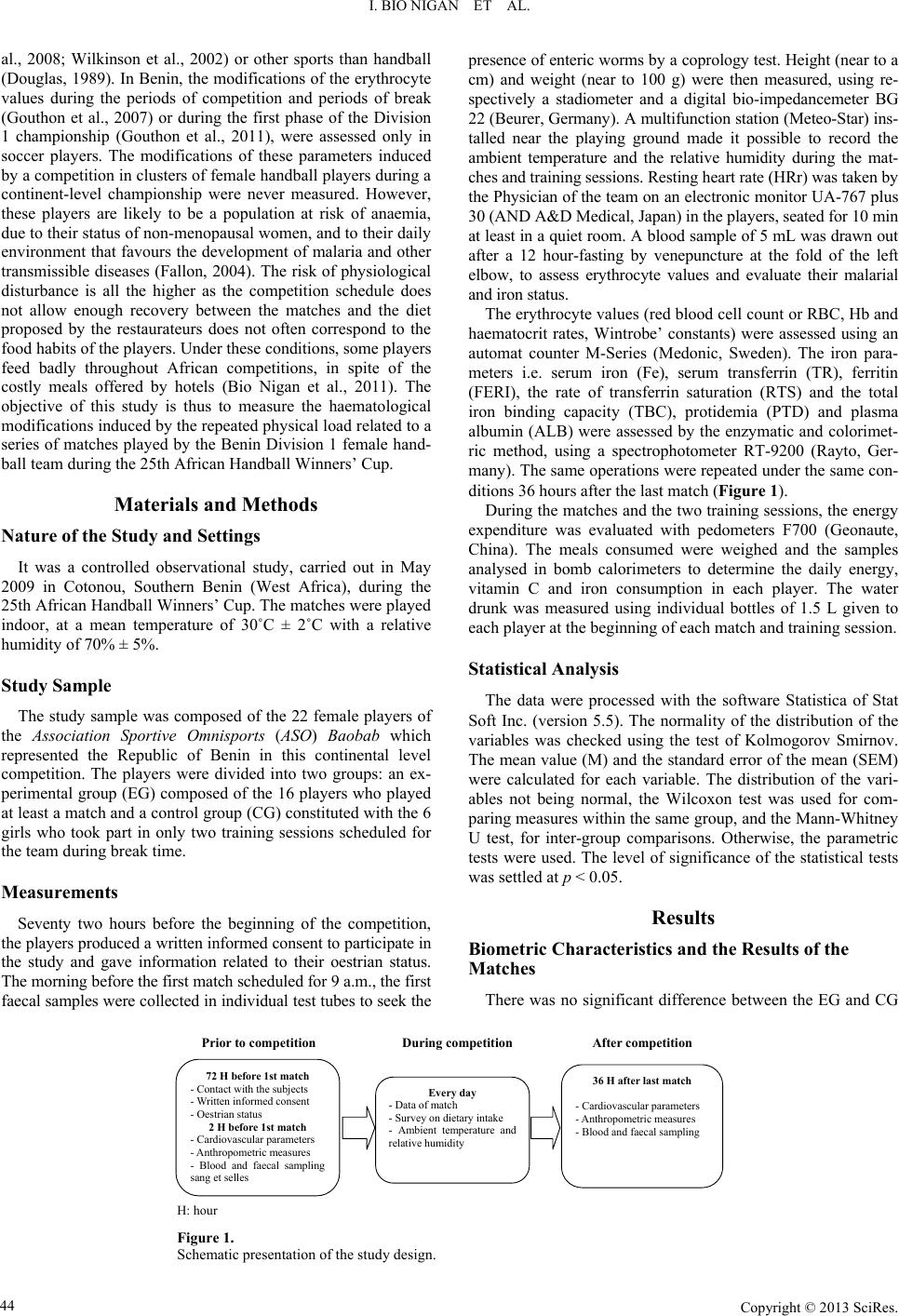 I. BIO NIGAN ET AL. al., 2008; Wilkinson et al., 2002) or other sports than handball (Douglas, 1989). In Benin, the modifications of the erythrocyte values during the periods of competition and periods of break (Gouthon et al., 2007) or during the first phase of the Division 1 championship (Gouthon et al., 2011), were assessed only in soccer players. The modifications of these parameters induced by a competition in clusters of female handball players during a continent-level championship were never measured. However, these players are likely to be a population at risk of anaemia, due to their status of non-menopausal women, and to their daily environment that favours the development of malaria and other transmissible diseases (Fallon, 2004). The risk of physiological disturbance is all the higher as the competition schedule does not allow enough recovery between the matches and the diet proposed by the restaurateurs does not often correspond to the food habits of the players. Under these conditions, some players feed badly throughout African competitions, in spite of the costly meals offered by hotels (Bio Nigan et al., 2011). The objective of this study is thus to measure the haematological modifications induced by the repeated physical load related to a series of matches played by the Benin Division 1 female hand- ball team during the 25th African Handball Winners’ Cup. Materials and Methods Nature of the Study an d Se tt ings It was a controlled observational study, carried out in May 2009 in Cotonou, Southern Benin (West Africa), during the 25th African Handball Winners’ Cup. The matches were played indoor, at a mean temperature of 30˚C ± 2˚C with a relative humidity of 70% ± 5%. Study Sample The study sample was composed of the 22 female players of the Association Sportive Omnisports (ASO) Baobab which represented the Republic of Benin in this continental level competition. The players were divided into two groups: an ex- perimental group (EG) composed of the 16 players who played at least a match and a control group (CG) constituted with the 6 girls who took part in only two training sessions scheduled for the team during break time. Measurements Seventy two hours before the beginning of the competition, the players produced a written informed consent to participate in the study and gave information related to their oestrian status. The morning before the first match scheduled for 9 a.m., the first faecal samples were collected in individual test tubes to seek the presence of enteric worms by a coprology test. Height (near to a cm) and weight (near to 100 g) were then measured, using re- spectively a stadiometer and a digital bio-impedancemeter BG 22 (Beurer, Germany). A multifunction station (Meteo-Star) ins- talled near the playing ground made it possible to record the ambient temperature and the relative humidity during the mat- ches and training sessions. Resting heart rate (HRr) was taken by the Physician of the team on an electronic monitor UA-767 plus 30 (AND A&D Medical, Japan) in the players, seated for 10 min at least in a quiet room. A blood sample of 5 mL was drawn out after a 12 hour-fasting by venepuncture at the fold of the left elbow, to assess erythrocyte values and evaluate their malarial and iron status. The erythrocyte values (red blood cell count or RBC, Hb and haematocrit rates, Wintrobe’ constants) were assessed using an automat counter M-Series (Medonic, Sweden). The iron para- meters i.e. serum iron (Fe), serum transferrin (TR), ferritin (FERI), the rate of transferrin saturation (RTS) and the total iron binding capacity (TBC), protidemia (PTD) and plasma albumin (ALB) were assessed by the enzymatic and colorimet- ric method, using a spectrophotometer RT-9200 (Rayto, Ger- many). The same operations were repeated under the same con- ditions 36 hours after the last match (Figure 1). During the matches and the two training sessions, the energy expenditure was evaluated with pedometers F700 (Geonaute, China). The meals consumed were weighed and the samples analysed in bomb calorimeters to determine the daily energy, vitamin C and iron consumption in each player. The water drunk was measured using individual bottles of 1.5 L given to each player at the beginning of each match and training session. Statistical Analysis The data were processed with the software Statistica of Stat Soft Inc. (version 5.5). The normality of the distribution of the variables was checked using the test of Kolmogorov Smirnov. The mean value (M) and the standard error of the mean (SEM) were calculated for each variable. The distribution of the vari- ables not being normal, the Wilcoxon test was used for com- paring measures within the same group, and the Mann-Whitney U test, for inter-group comparisons. Otherwise, the parametric tests were used. The level of significance of the statistical tests was settled at p < 0.05. Results Biometric Characteristics and the Results of the Matches There was no significant difference between the EG and CG 72 H before 1st match - Contact with the subjects - Written informed consent - Oestrian status 2 H before 1st match - Cardiovascular parameters - Anthropometric measures - Blood and faecal sampling sang et selles Every day - Data of match - Survey on dietary intake - Ambient temperature and relative humidity 36 H after last match - Cardiovascular parameters - Anthropometric measures - Blood and faecal sampling Prior to competition During competition After competition H: hour Figure 1. Schematic presentation of the study design. Copyright © 2013 SciRes. 44 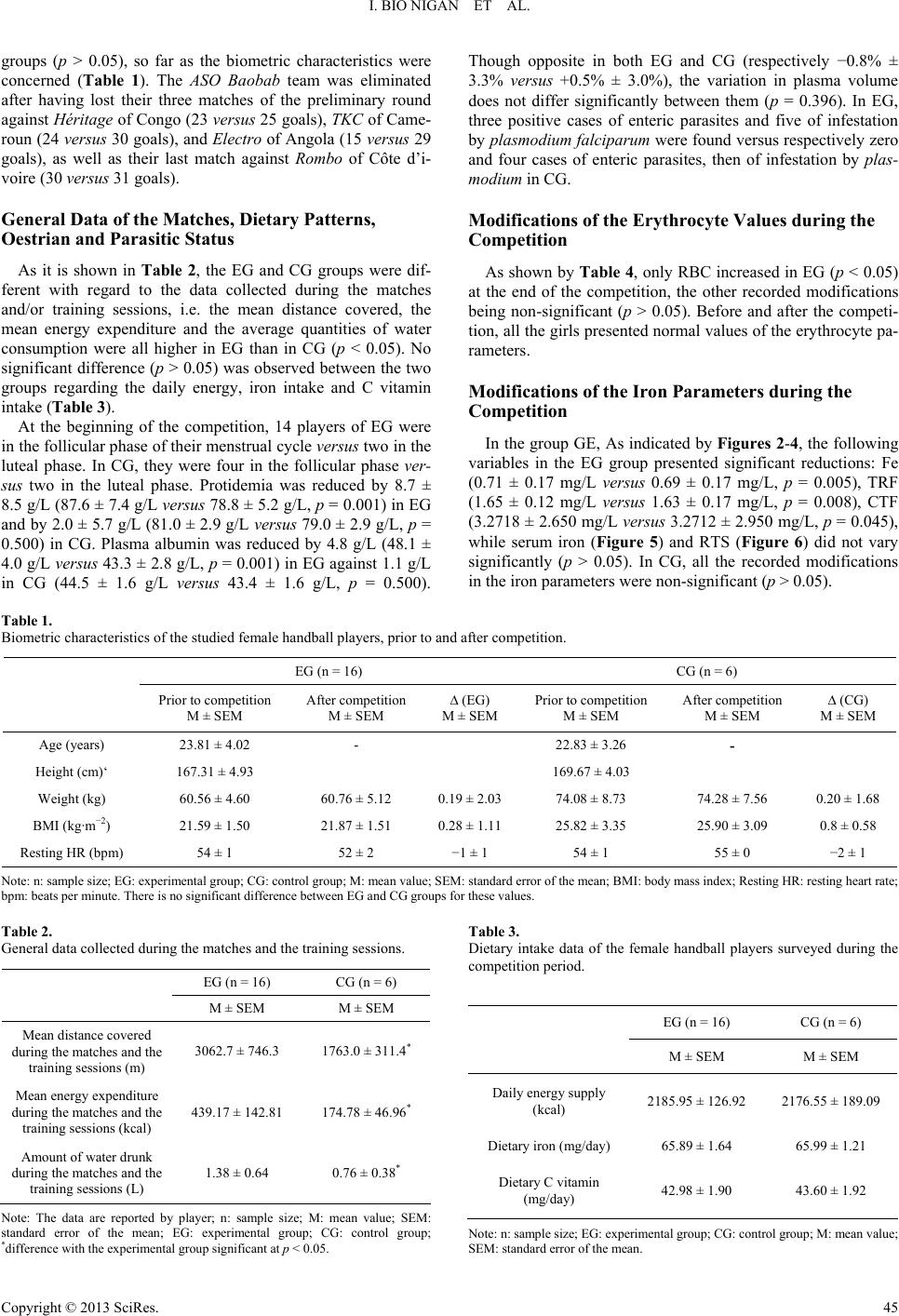 I. BIO NIGAN ET AL. groups (p > 0.05), so far as the biometric characteristics were concerned (Table 1). The ASO Baobab team was eliminated after having lost their three matches of the preliminary round against Héritage of Congo (23 versus 25 goals), TKC of Came- roun (24 versus 30 goals), and Electro of Angola (15 versus 29 goals), as well as their last match against Rombo of Côte d’i- voire (30 versus 31 goals). General Data of the Matches, Dietary Patterns, Oestrian and Parasitic Status As it is shown in Table 2, the EG and CG groups were dif- ferent with regard to the data collected during the matches and/or training sessions, i.e. the mean distance covered, the mean energy expenditure and the average quantities of water consumption were all higher in EG than in CG (p < 0.05). No significant difference (p > 0.05) was observed between the two groups regarding the daily energy, iron intake and C vitamin intake (Table 3). At the beginning of the competition, 14 players of EG were in the follicular phase of their menstrual cycle versus two in the luteal phase. In CG, they were four in the follicular phase ver- sus two in the luteal phase. Protidemia was reduced by 8.7 ± 8.5 g/L (87.6 ± 7.4 g/L versus 78.8 ± 5.2 g/L, p = 0.001) in EG and by 2.0 ± 5.7 g/L (81.0 ± 2.9 g/L versus 79.0 ± 2.9 g/L, p = 0.500) in CG. Plasma albumin was reduced by 4.8 g/L (48.1 ± 4.0 g/L versus 43.3 ± 2.8 g/L, p = 0.001) in EG against 1.1 g/L in CG (44.5 ± 1.6 g/L versus 43.4 ± 1.6 g/L, p = 0.500). Though opposite in both EG and CG (respectively −0.8% ± 3.3% versus +0.5% ± 3.0%), the variation in plasma volume does not differ significantly between them (p = 0.396). In EG, three positive cases of enteric parasites and five of infestation by plasmodium falciparum were found versus respectively zero and four cases of enteric parasites, then of infestation by plas- modium in CG. Modifications of the Erythrocyte Values during the Competition As shown by Table 4, only RBC increased in EG (p < 0.05) at the end of the competition, the other recorded modifications being non-significant (p > 0.05). Before and after the competi- tion, all the girls presented normal values of the erythrocyte pa- rameters. Modifications of the Iron Parameters during the Competition In the group GE, As indicated by Figures 2-4, the following variables in the EG group presented significant reductions: Fe (0.71 ± 0.17 mg/L versus 0.69 ± 0.17 mg/L, p = 0.005), TRF (1.65 ± 0.12 mg/L versus 1.63 ± 0.17 mg/L, p = 0.008), CTF (3.2718 ± 2.650 mg/L versus 3.2712 ± 2.950 mg/L, p = 0.045), while serum iron (Figure 5) and RTS (Figure 6) did not vary significantly (p > 0.05). In CG, all the recorded modifications n the iron parameters were non-significant (p > 0.05). i Table 1. Biometric characteristics of the studied female handball players, prior to and after competition. EG (n = 16) CG (n = 6) Prior to competition M ± SEM After competition M ± SEM ∆ (EG) M ± SEM Prior to competition M ± SEM After competition M ± SEM ∆ (CG) M ± SEM Age (years) 23.81 ± 4.02 - 22.83 ± 3.26 - Height (cm)‘ 167.31 ± 4.93 169.67 ± 4.03 Weight (kg) 60.56 ± 4.60 60.76 ± 5.12 0.19 ± 2.03 74.08 ± 8.73 74.28 ± 7.56 0.20 ± 1.68 BMI (kg·m−2) 21.59 ± 1.50 21.87 ± 1.51 0.28 ± 1.11 25.82 ± 3.35 25.90 ± 3.09 0.8 ± 0.58 Resting HR (bpm) 54 ± 1 52 ± 2 −1 ± 1 54 ± 1 55 ± 0 −2 ± 1 Note: n: sample size; EG: experimental group; CG: control group; M: mean value; SEM: standard error of the mean; BMI: body mass index; Resting HR: resting heart rate; bpm: beats per minute. There is no significant difference between EG and CG groups for these values. Table 2. General data collected during the matches and the training sessions. EG (n = 16) CG (n = 6) M ± SEM M ± SEM Mean distance covered during the matches and the training sessions (m) 3062.7 ± 746.3 1763.0 ± 311.4* Mean energy expenditure during the matches and the training sessions (kcal) 439.17 ± 142.81 174.78 ± 46.96* Amount of water drunk during the matches and the training sessions (L) 1.38 ± 0.64 0.76 ± 0.38* Note: The data are reported by player; n: sample size; M: mean value; SEM: standard error of the mean; EG: experimental group; CG: control group; *difference with the experimental group significant at p < 0.05. Table 3. Dietary intake data of the female handball players surveyed during the competition period. EG (n = 16) CG (n = 6) M ± SEM M ± SEM Daily energy supply (kcal) 2185.95 ± 126.92 2176.55 ± 189.09 Dietary iron (mg/day) 65.89 ± 1.64 65.99 ± 1.21 Dietary C vitamin (mg/day) 42.98 ± 1.90 43.60 ± 1.92 Note: n: sample size; EG: experimental group; CG: control group; M: mean value; SEM: standard error of the mean. Copyright © 2013 SciRes. 45 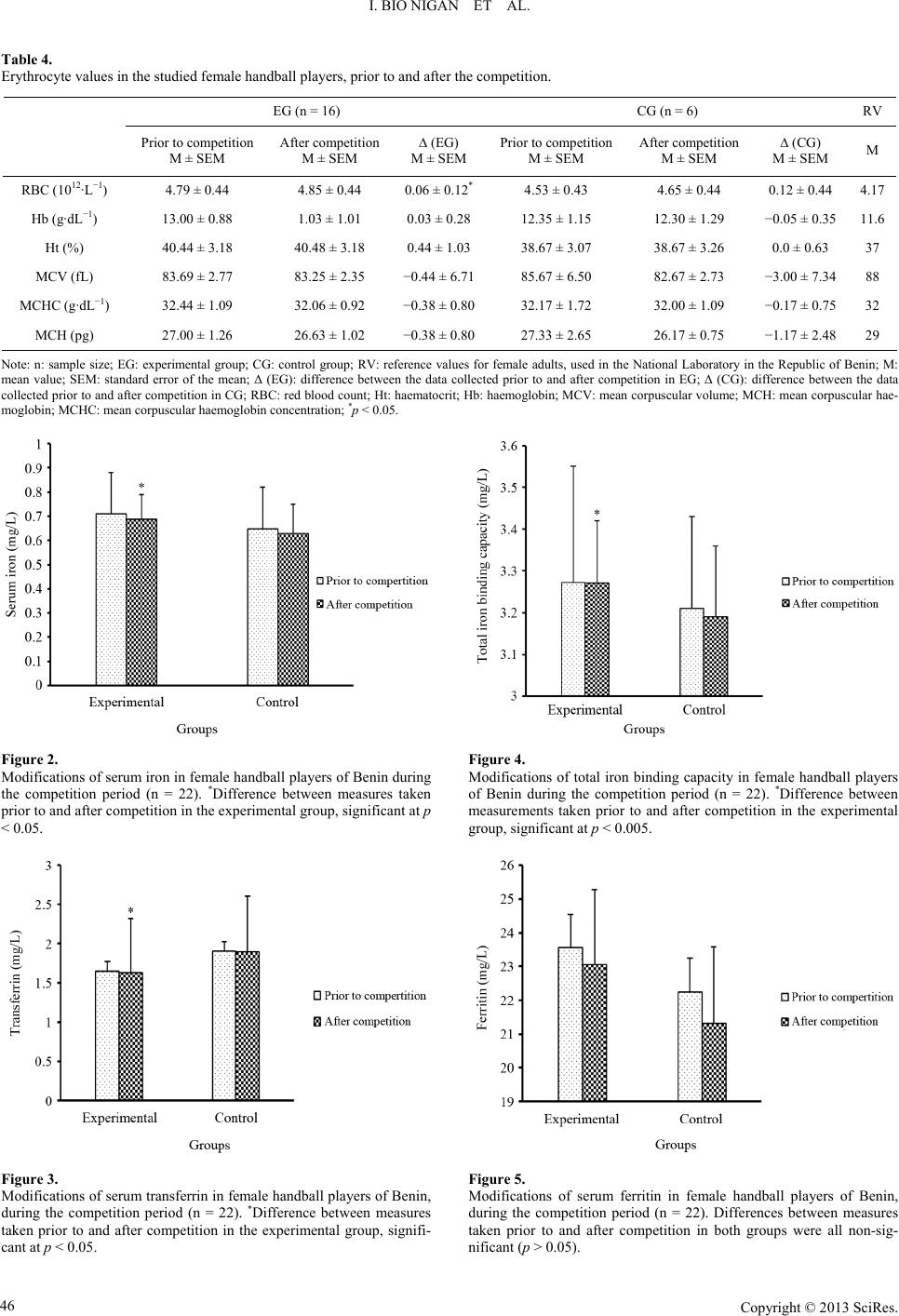 I. BIO NIGAN ET AL. Table 4. Erythrocyte values in the studied female handball players, prior to and after the competition. EG (n = 16) CG (n = 6) RV Prior to competition M ± SEM After competition M ± SEM ∆ (EG) M ± SEM Prior to competition M ± SEM After competition M ± SEM ∆ (CG) M ± SEM M RBC (1012·L−1) 4.79 ± 0.44 4.85 ± 0.44 0.06 ± 0.12* 4.53 ± 0.43 4.65 ± 0.44 0.12 ± 0.44 4.17 Hb (g·dL−1) 13.00 ± 0.88 1.03 ± 1.01 0.03 ± 0.28 12.35 ± 1.15 12.30 ± 1.29 −0.05 ± 0.3511.6 Ht (%) 40.44 ± 3.18 40.48 ± 3.18 0.44 ± 1.03 38.67 ± 3.07 38.67 ± 3.26 0.0 ± 0.63 37 MCV (fL) 83.69 ± 2.77 83.25 ± 2.35 −0.44 ± 6.7185.67 ± 6.50 82.67 ± 2.73 −3.00 ± 7.3488 MCHC (g·dL−1) 32.44 ± 1.09 32.06 ± 0.92 −0.38 ± 0.8032.17 ± 1.72 32.00 ± 1.09 −0.17 ± 0.7532 MCH (pg) 27.00 ± 1.26 26.63 ± 1.02 −0.38 ± 0.8027.33 ± 2.65 26.17 ± 0.75 −1.17 ± 2.4829 Note: n: sample size; EG: experimental group; CG: control group; RV: reference values for female adults, used in the National Laboratory in the Republic of Benin; M: mean value; SEM: standard error of the mean; Δ (EG): difference between the data collected prior to and after competition in EG; Δ (CG): difference between the data collected prior to and after competition in CG; RBC: red blood count; Ht: haematocrit; Hb: haemoglobin; MCV: mean corpuscular volume; MCH: mean corpuscular hae- moglobin; MCHC: mean corpuscular haemoglobin concentration; *p < 0.05. Figure 2. Modifications of serum iron in female handball players of Benin during the competition period (n = 22). *Difference between measures taken prior to and after competition in the experimental group, significant at p < 0.05. Figure 3. Modifications of serum transferrin in female handball players of Benin, during the competition period (n = 22). *Difference between measures taken prior to and after competition in the experimental group, signifi- cant at p < 0.05. Figure 4. Modifications of total iron binding capacity in female handball players of Benin during the competition period (n = 22). *Difference between measurements taken prior to and after competition in the experimental group, significant at p < 0.005. Figure 5. Modifications of serum ferritin in female handball players of Benin, during the competition period (n = 22). Differences between measures taken prior to and after competition in both groups were all non-sig- nificant (p > 0.05). Copyright © 2013 SciRes. 46 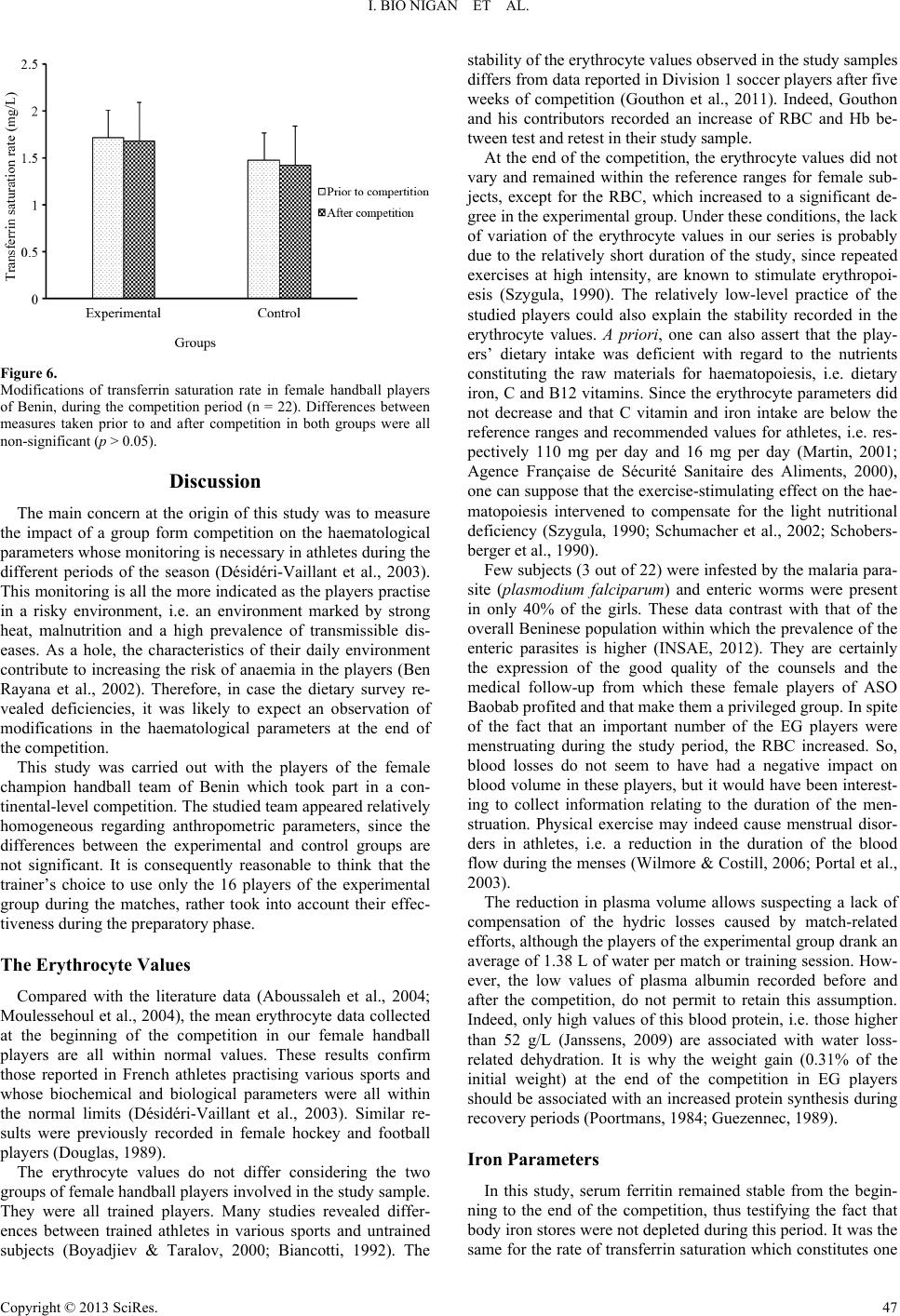 I. BIO NIGAN ET AL. Figure 6. Modifications of transferrin saturation rate in female handball players of Benin, during the competition period (n = 22). Differences between measures taken prior to and after competition in both groups were all non-significant (p > 0.05). Discussion The main concern at the origin of this study was to measure the impact of a group form competition on the haematological parameters whose monitoring is necessary in athletes during the different periods of the season (Désidéri-Vaillant et al., 2003). This monitoring is all the more indicated as the players practise in a risky environment, i.e. an environment marked by strong heat, malnutrition and a high prevalence of transmissible dis- eases. As a hole, the characteristics of their daily environment contribute to increasing the risk of anaemia in the players (Ben Rayana et al., 2002). Therefore, in case the dietary survey re- vealed deficiencies, it was likely to expect an observation of modifications in the haematological parameters at the end of the competition. This study was carried out with the players of the female champion handball team of Benin which took part in a con- tinental-level competition. The studied team appeared relatively homogeneous regarding anthropometric parameters, since the differences between the experimental and control groups are not significant. It is consequently reasonable to think that the trainer’s choice to use only the 16 players of the experimental group during the matches, rather took into account their effec- tiveness during the preparatory phase. The Erythrocyte Values Compared with the literature data (Aboussaleh et al., 2004; Moulessehoul et al., 2004), the mean erythrocyte data collected at the beginning of the competition in our female handball players are all within normal values. These results confirm those reported in French athletes practising various sports and whose biochemical and biological parameters were all within the normal limits (Désidéri-Vaillant et al., 2003). Similar re- sults were previously recorded in female hockey and football players (Douglas, 1989). The erythrocyte values do not differ considering the two groups of female handball players involved in the study sample. They were all trained players. Many studies revealed differ- ences between trained athletes in various sports and untrained subjects (Boyadjiev & Taralov, 2000; Biancotti, 1992). The stability of the erythrocyte values observed in the study samples differs from data reported in Division 1 soccer players after five weeks of competition (Gouthon et al., 2011). Indeed, Gouthon and his contributors recorded an increase of RBC and Hb be- tween test and retest in their study sample. At the end of the competition, the erythrocyte values did not vary and remained within the reference ranges for female sub- jects, except for the RBC, which increased to a significant de- gree in the experimental group. Under these conditions, the lack of variation of the erythrocyte values in our series is probably due to the relatively short duration of the study, since repeated exercises at high intensity, are known to stimulate erythropoi- esis (Szygula, 1990). The relatively low-level practice of the studied players could also explain the stability recorded in the erythrocyte values. A priori, one can also assert that the play- ers’ dietary intake was deficient with regard to the nutrients constituting the raw materials for haematopoiesis, i.e. dietary iron, C and B12 vitamins. Since the erythrocyte parameters did not decrease and that C vitamin and iron intake are below the reference ranges and recommended values for athletes, i.e. res- pectively 110 mg per day and 16 mg per day (Martin, 2001; Agence Française de Sécurité Sanitaire des Aliments, 2000), one can suppose that the exercise-stimulating effect on the hae- matopoiesis intervened to compensate for the light nutritional deficiency (Szygula, 1990; Schumacher et al., 2002; Schobers- berger et al., 1990). Few subjects (3 out of 22) were infested by the malaria para- site (plasmodium falciparum) and enteric worms were present in only 40% of the girls. These data contrast with that of the overall Beninese population within which the prevalence of the enteric parasites is higher (INSAE, 2012). They are certainly the expression of the good quality of the counsels and the medical follow-up from which these female players of ASO Baobab profited and that make them a privileged group. In spite of the fact that an important number of the EG players were menstruating during the study period, the RBC increased. So, blood losses do not seem to have had a negative impact on blood volume in these players, but it would have been interest- ing to collect information relating to the duration of the men- struation. Physical exercise may indeed cause menstrual disor- ders in athletes, i.e. a reduction in the duration of the blood flow during the menses (Wilmore & Costill, 2006; Portal et al., 2003). The reduction in plasma volume allows suspecting a lack of compensation of the hydric losses caused by match-related efforts, although the players of the experimental group drank an average of 1.38 L of water per match or training session. How- ever, the low values of plasma albumin recorded before and after the competition, do not permit to retain this assumption. Indeed, only high values of this blood protein, i.e. those higher than 52 g/L (Janssens, 2009) are associated with water loss- related dehydration. It is why the weight gain (0.31% of the initial weight) at the end of the competition in EG players should be associated with an increased protein synthesis during recovery periods (Poortmans, 1984; Guezennec, 1989). Iron Parameters In this study, serum ferritin remained stable from the begin- ning to the end of the competition, thus testifying the fact that body iron stores were not depleted during this period. It was the same for the rate of transferrin saturation which constitutes one Copyright © 2013 SciRes. 47 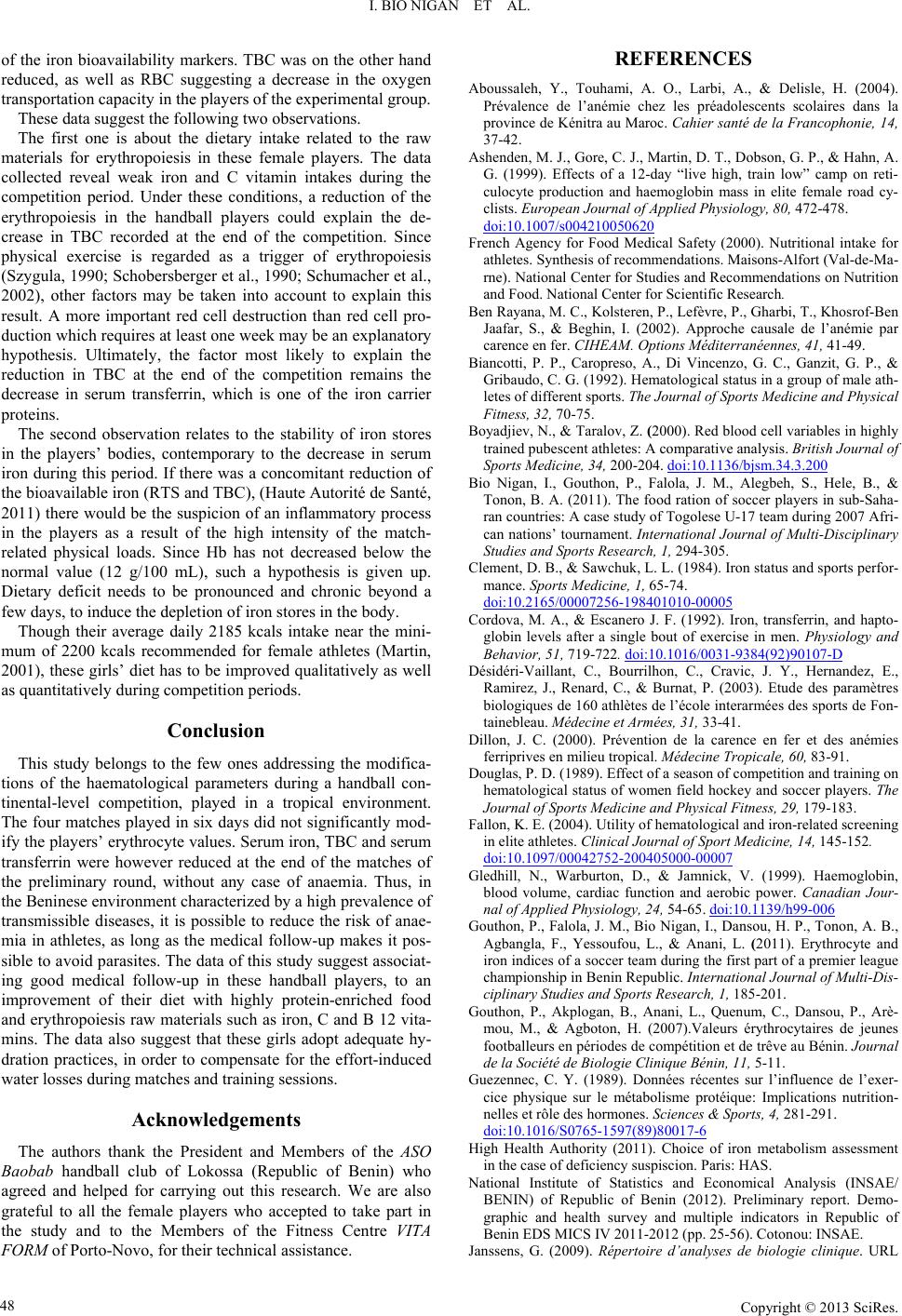 I. BIO NIGAN ET AL. of the iron bioavailability markers. TBC was on the other hand reduced, as well as RBC suggesting a decrease in the oxygen transportation capacity in the players of the experimental group. These data suggest the following two observations. The first one is about the dietary intake related to the raw materials for erythropoiesis in these female players. The data collected reveal weak iron and C vitamin intakes during the competition period. Under these conditions, a reduction of the erythropoiesis in the handball players could explain the de- crease in TBC recorded at the end of the competition. Since physical exercise is regarded as a trigger of erythropoiesis (Szygula, 1990; Schobersberger et al., 1990; Schumacher et al., 2002), other factors may be taken into account to explain this result. A more important red cell destruction than red cell pro- duction which requires at least one week may be an explanatory hypothesis. Ultimately, the factor most likely to explain the reduction in TBC at the end of the competition remains the decrease in serum transferrin, which is one of the iron carrier proteins. The second observation relates to the stability of iron stores in the players’ bodies, contemporary to the decrease in serum iron during this period. If there was a concomitant reduction of the bioavailable iron (RTS and TBC), (Haute Autorité de Santé, 2011) there would be the suspicion of an inflammatory process in the players as a result of the high intensity of the match- related physical loads. Since Hb has not decreased below the normal value (12 g/100 mL), such a hypothesis is given up. Dietary deficit needs to be pronounced and chronic beyond a few days, to induce the depletion of iron stores in the body. Though their average daily 2185 kcals intake near the mini- mum of 2200 kcals recommended for female athletes (Martin, 2001), these girls’ diet has to be improved qualitatively as well as quantitatively during competition periods. Conclusion This study belongs to the few ones addressing the modifica- tions of the haematological parameters during a handball con- tinental-level competition, played in a tropical environment. The four matches played in six days did not significantly mod- ify the players’ erythrocyte values. Serum iron, TBC and serum transferrin were however reduced at the end of the matches of the preliminary round, without any case of anaemia. Thus, in the Beninese environment characterized by a high prevalence of transmissible diseases, it is possible to reduce the risk of anae- mia in athletes, as long as the medical follow-up makes it pos- sible to avoid parasites. The data of this study suggest associat- ing good medical follow-up in these handball players, to an improvement of their diet with highly protein-enriched food and erythropoiesis raw materials such as iron, C and B 12 vita- mins. The data also suggest that these girls adopt adequate hy- dration practices, in order to compensate for the effort-induced water losses during matches and training sessions. Acknowledgements The authors thank the President and Members of the ASO Baobab handball club of Lokossa (Republic of Benin) who agreed and helped for carrying out this research. We are also grateful to all the female players who accepted to take part in the study and to the Members of the Fitness Centre VITA FORM of Porto-Novo, for their technical assistance. REFERENCES Aboussaleh, Y., Touhami, A. O., Larbi, A., & Delisle, H. (2004). Prévalence de l’anémie chez les préadolescents scolaires dans la province de Kénitra au Maroc. Cahier santé de la Francophonie, 14, 37-42. Ashenden, M. J., Gore, C. J., Martin, D. T., Dobson, G. P., & Hahn, A. G. (1999). Effects of a 12-day “live high, train low” camp on reti- culocyte production and haemoglobin mass in elite female road cy- clists. European Journal of A pp li e d Physiology, 80, 472-478. doi:10.1007/s004210050620 French Agency for Food Medical Safety (2000). Nutritional intake for athletes. Synthesis of recommendations. Maisons-Alfort (Val-de-Ma- rne). National Center for Studies and Recommendations on Nutrition and Food. National Center for Scientific Research. Ben Rayana, M. C., Kolsteren, P., Lefèvre, P., Gharbi, T., Khosrof-Ben Jaafar, S., & Beghin, I. (2002). Approche causale de l’anémie par carence en fer. CIHEAM. Opti o n s Méditerranéennes, 41, 41-49. Biancotti, P. P., Caropreso, A., Di Vincenzo, G. C., Ganzit, G. P., & Gribaudo, C. G. (1992). Hematological status in a group of male ath- letes of different sports. The Journal of Sports Medicine and Physical Fitness, 32, 70-75. Boyadjiev, N., & Taralov, Z. (2000). Red blood cell variables in highly trained pubescent athletes: A comparative analysis. British Journal of Sports Medicine, 3 4, 200-204. doi:10.1136/bjsm.34.3.200 Bio Nigan, I., Gouthon, P., Falola, J. M., Alegbeh, S., Hele, B., & Tonon, B. A. (2011). The food ration of soccer players in sub-Saha- ran countries: A case study of Togolese U-17 team during 2007 Afri- can nations’ tournament. International Journal of Multi-Disciplinary Studies and Sports R esearch, 1, 294-305. Clement, D. B., & Sawchuk, L. L. (1984). Iron status and sports perfor- mance. Sports Medicine, 1, 65-74. doi:10.2165/00007256-198401010-00005 Cordova, M. A., & Escanero J. F. (1992). Iron, transferrin, and hapto- globin levels after a single bout of exercise in men. Physiology and Behavior, 51, 719-722. doi:10.1016/0031-9384(92)90107-D Désidéri-Vaillant, C., Bourrilhon, C., Cravic, J. Y., Hernandez, E., Ramirez, J., Renard, C., & Burnat, P. (2003). Etude des paramètres biologiques de 160 athlètes de l’école interarmées des sports de Fon- tainebleau. Médecine et Armées, 31, 33-41. Dillon, J. C. (2000). Prévention de la carence en fer et des anémies ferriprives en milieu tropical. Médecine Tropica l e , 60, 83-91. Douglas, P. D. (1989). Effect of a season of competition and training on hematological status of women field hockey and soccer players. The Journal of Sports Medicine and Physical F itness, 29, 179-183. Fallon, K. E. (2004). Utility of hematological and iron-related screening in elite athletes. Clinical Journal of Sport Medicine, 14, 145-152. doi:10.1097/00042752-200405000-00007 Gledhill, N., Warburton, D., & Jamnick, V. (1999). Haemoglobin, blood volume, cardiac function and aerobic power. Canadian Jour- nal of Applied Physiology, 24, 54-65. doi:10.1139/h99-006 Gouthon, P., Falola, J. M., Bio Nigan, I., Dansou, H. P., Tonon, A. B., Agbangla, F., Yessoufou, L., & Anani, L. (2011). Erythrocyte and iron indices of a soccer team during the first part of a premier league championship in Benin Republic. International Journal of Multi-Dis- ciplinary Studies and Sports Research, 1, 185-201. Gouthon, P., Akplogan, B., Anani, L., Quenum, C., Dansou, P., Arè- mou, M., & Agboton, H. (2007).Valeurs érythrocytaires de jeunes footballeurs en périodes de compétition et de trêve au Bénin. Journal de la Société de Biologie Clinique Bénin, 11, 5-11. Guezennec, C. Y. (1989). Données récentes sur l’influence de l’exer- cice physique sur le métabolisme protéique: Implications nutrition- nelles et rôle des hormones. Sciences & Sports, 4, 281-291. doi:10.1016/S0765-1597(89)80017-6 High Health Authority (2011). Choice of iron metabolism assessment in the case of deficiency suspiscion. Paris: HAS. National Institute of Statistics and Economical Analysis (INSAE/ BENIN) of Republic of Benin (2012). Preliminary report. Demo- graphic and health survey and multiple indicators in Republic of Benin EDS MICS IV 2011-2012 (pp. 25-56). Cotonou: INSAE. Janssens, G. (2009). Répertoire d’analyses de biologie clinique. URL Copyright © 2013 SciRes. 48 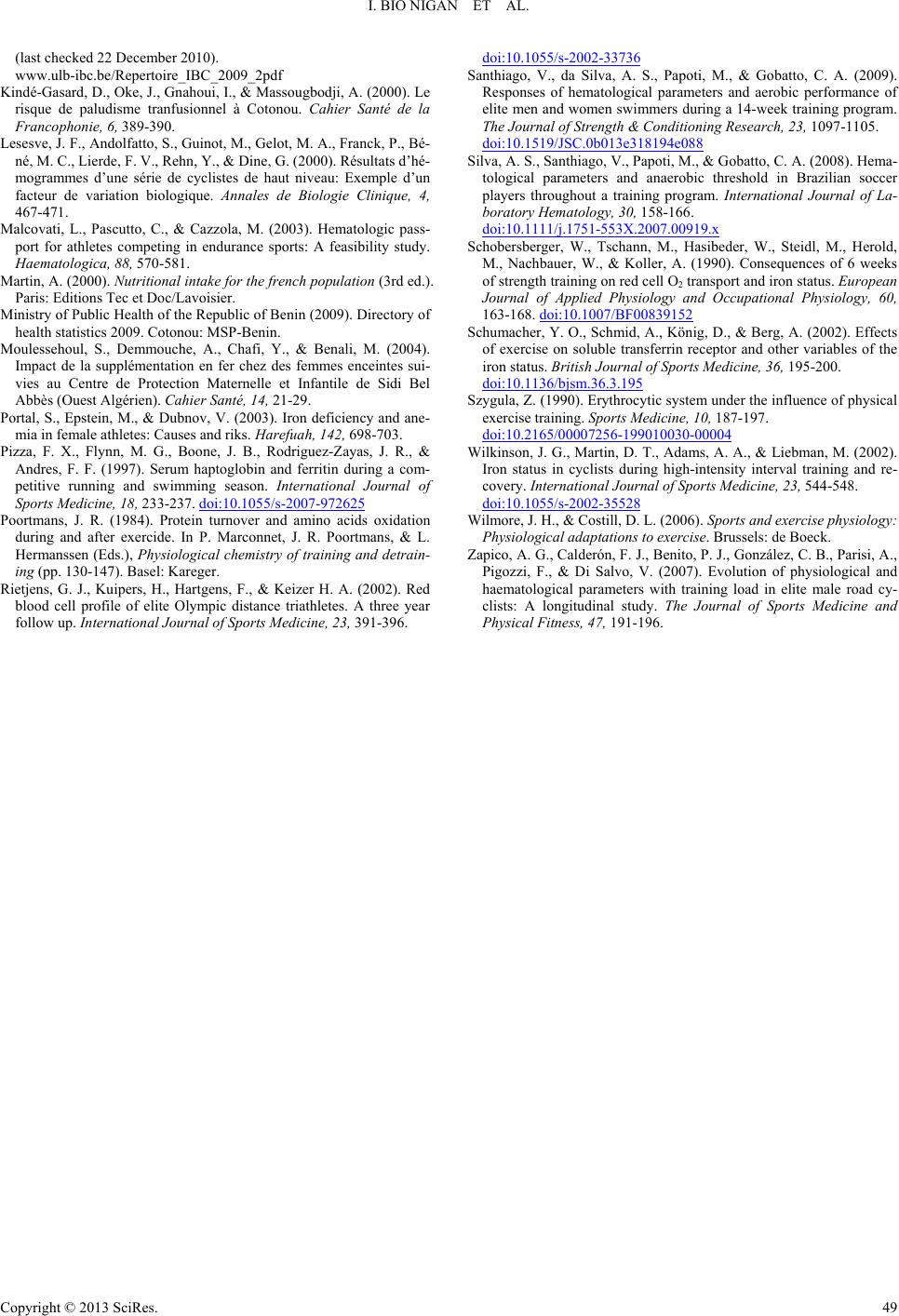 I. BIO NIGAN ET AL. Copyright © 2013 SciRes. 49 (last checked 22 December 2010). www.ulb-ibc.be/Repertoire_IBC_2009_2pdf Kindé-Gasard, D., Oke, J., Gnahoui, I., & Massougbodji, A. (2000). Le risque de paludisme tranfusionnel à Cotonou. Cahier Santé de la Francophonie, 6, 389-390. Lesesve, J. F., Andolfatto, S., Guinot, M., Gelot, M. A., Franck, P., Bé- né, M. C., Lierde, F. V., Rehn, Y., & Dine, G. (2000). Résultats d’hé- mogrammes d’une série de cyclistes de haut niveau: Exemple d’un facteur de variation biologique. Annales de Biologie Clinique, 4, 467-471. Malcovati, L., Pascutto, C., & Cazzola, M. (2003). Hematologic pass- port for athletes competing in endurance sports: A feasibility study. Haematologica, 88, 570-581. Martin, A. (2000). Nutritional intake for the french population (3rd ed.). Paris: Editions Tec et Doc/Lavoisier. Ministry of Public Health of the Republic of Benin (2009). Directory of health statistics 2009. Cotonou: MSP-Benin. Moulessehoul, S., Demmouche, A., Chafi, Y., & Benali, M. (2004). Impact de la supplémentation en fer chez des femmes enceintes sui- vies au Centre de Protection Maternelle et Infantile de Sidi Bel Abbès (Ouest Algérien). Cahier Santé, 14, 21-29. Portal, S., Epstein, M., & Dubnov, V. (2003). Iron deficiency and ane- mia in female athletes: Causes and riks. Harefuah, 142, 698-703. Pizza, F. X., Flynn, M. G., Boone, J. B., Rodriguez-Zayas, J. R., & Andres, F. F. (1997). Serum haptoglobin and ferritin during a com- petitive running and swimming season. International Journal of Sports Medicine, 1 8, 233-237. doi:10.1055/s-2007-972625 Poortmans, J. R. (1984). Protein turnover and amino acids oxidation during and after exercide. In P. Marconnet, J. R. Poortmans, & L. Hermanssen (Eds.), Physiological chemistry of training and detrain- ing (pp. 130-147). Basel: Kareger. Rietjens, G. J., Kuipers, H., Hartgens, F., & Keizer H. A. (2002). Red blood cell profile of elite Olympic distance triathletes. A three year follow up. International Journal of Sports Medicine, 23, 391-396. doi:10.1055/s-2002-33736 Santhiago, V., da Silva, A. S., Papoti, M., & Gobatto, C. A. (2009). Responses of hematological parameters and aerobic performance of elite men and women swimmers during a 14-week training program. The Journal of Strength & Conditioning R esearch, 23, 1097-1105. doi:10.1519/JSC.0b013e318194e088 Silva, A. S., Santhiago, V., Papoti, M., & Gobatto, C. A. (2008). Hema- tological parameters and anaerobic threshold in Brazilian soccer players throughout a training program. International Journal of La- boratory Hematology, 3 0 , 158-166. doi:10.1111/j.1751-553X.2007.00919.x Schobersberger, W., Tschann, M., Hasibeder, W., Steidl, M., Herold, M., Nachbauer, W., & Koller, A. (1990). Consequences of 6 weeks of strength training on red cell O2 transport and iron status. European Journal of Applied Physiology and Occupational Physiology, 60, 163-168. doi:10.1007/BF00839152 Schumacher, Y. O., Schmid, A., König, D., & Berg, A. (2002). Effects of exercise on soluble transferrin receptor and other variables of the iron status. British Journal of Sports Medicine , 36, 195-200. doi:10.1136/bjsm.36.3.195 Szygula, Z. (1990). Erythrocytic system under the influence of physical exercise training. Sports Medicine, 10, 187-197. doi:10.2165/00007256-199010030-00004 Wilkinson, J. G., Martin, D. T., Adams, A. A., & Liebman, M. (2002). Iron status in cyclists during high-intensity interval training and re- covery. International Journal of Sports Medicine, 23, 544-548. doi:10.1055/s-2002-35528 Wilmore, J. H., & Costill, D. L. (2006). Sports and exercise physiology: Physiological adaptations to exercise. Brussels: de Boeck. Zapico, A. G., Calderón, F. J., Benito, P. J., González, C. B., Parisi, A., Pigozzi, F., & Di Salvo, V. (2007). Evolution of physiological and haematological parameters with training load in elite male road cy- clists: A longitudinal study. The Journal of Sports Medicine and Physical Fitness, 47, 191-196.
|